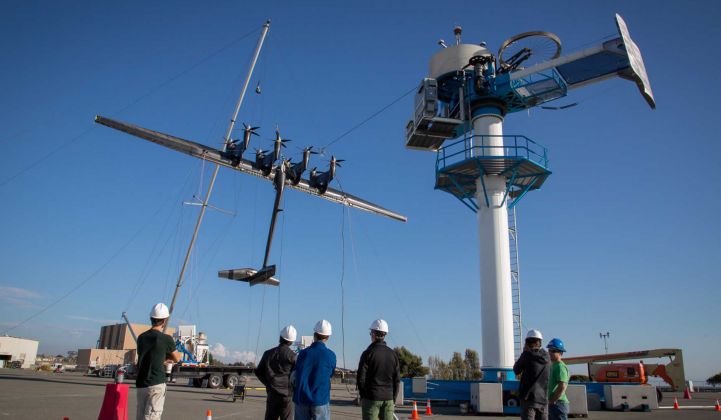Airborne wind turbines have been in the news recently.
Last month, Bloomberg published a less-than-flattering review of progress at Makani, an energy kite concept being developed by Alphabet, Google’s parent, in its X incubator arm.
Sources at X told GTM the Bloomberg report was inaccurate and did not reflect the present status of the project. Alphabet remains fully committed to Makani, they said.
Elsewhere, though, slow progress at airborne wind turbine startups is a testimony to the challenges associated with harvesting the strong, steady winds high above the ground. For the uninitiated, here is a rundown of some of the main contenders.
Ampyx Power

European Commission-funded Ampyx is working on a tethered glider that, it says, will rotate across the same area as a massive land-based turbine, but without the need for a tower, nacelle or blades.
It is one of a handful of projects to have announced any progress in recent months, trumpeting the selection of an autopilot system in July.
EnerKite

EnerKite’s swept rigid wind design is intended to harvest power by flying increasingly high figure-eight patterns and dropping down to repeat the process. Its portable pumping kite generator has a continuous rated power of 30 kilowatts and can be installed on a truck.
The German startup says it will be attending this month’s Husum Wind trade fair, but other news on the venture is lacking.
Kitenergy

Kitenergy, of Turin, Italy, has been winning awards since 2010 and has even been featured in Forbes. (For the most part, awards in this space may say more about novelty than long-term viability.)
As with many other contenders in this space, though, early enthusiasm for Kitenergy’s 60-kilowatt foil kite wind energy harvesting device has waned in recent years as commercialization has dragged out.
KiteGen

Part of Kitenergy’s DNA comes from KiteGen, one of the first companies to tout an airborne wind turbine technology. KiteGen tested the steering unit for its semi-rigid wing design in 2006 and aimed to develop a 3-megawatt land-based generator that could be powered by the kite.
The company still appears to be active, announcing the opening of wing composite production facility in March. But, like all the other names listed here except Makani, it did not respond to a request for information from GTM.
Makani Power

U.S.-based Makani was founded in 2006, got a Department of Energy Advanced Research Projects Agency for a 20-kilowatt turbine-carrying glider in 2009 and was snapped up by Google in 2013, disappearing into the search engine giant’s X moonshot hothouse.
Today Makani is airborne wind energy’s brightest hope, thanks to its parent’s deep pockets, if nothing else. “The amount of venture capital that Google can throw into that project is…infinity,” said Prashant Khorana, renewable energy analyst at MAKE Consulting.
SkySails Power

Germany’s SkySails attached its foil kite energy harvesting device to a yacht and powered the vessel across the Atlantic this year, according to a press release in June.
The captain of the ship, a catamaran called Race for Water, reported a happy side effect: As the kite was pulling the yacht through the water, it set the propellers spinning, providing energy to recharge batteries.
The accomplishment was a major coup for an airborne wind energy company focused mostly on the marine market.
And others...
Six startups might seem plenty for a technology that nobody has commercialize yet, but there are many more.
Other hopefuls include Airborne Wind Energy Labs, Altaeros Energies, e-Kite, Enevate, eWind, Joby Energy, Kitemill, Laddermill, LTA Windpower, NTS Energie, Sky WindPower, TwingTec and Windlift.
On top of this, there have been numerous concepts from academic and research organizations including Delft University of Technology, KU Leuven, SwissKitePower, NASA Langley Research Center, the University of Grenoble, Sussex University and Worcester Polytechnic Institute.
Of these, only about half a dozen are anywhere close to commercialization, Khorana said. And the likelihood of airborne wind energy becoming a commercial proposition any time before 2025 is remote. Currently it’s about 10 times more costly than traditional wind generation.
However, according to Khorana: “It’s impossible to rule it out as a technology. In principle, it’s a great idea. It could work.”



